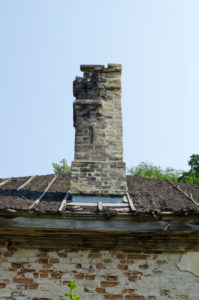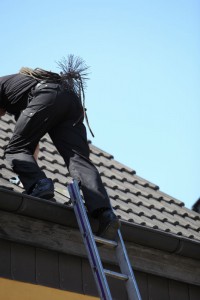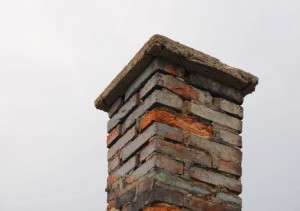 There are a number of ways we get our fireplaces ready for winter; having them swept, buying new firewood, and sweeping out ashes and coals are all ways to make sure your fireplace is safe and ready to use. However, there may be hidden hazards hiding in your chimney liner.
There are a number of ways we get our fireplaces ready for winter; having them swept, buying new firewood, and sweeping out ashes and coals are all ways to make sure your fireplace is safe and ready to use. However, there may be hidden hazards hiding in your chimney liner.
A properly lined chimney is an important part of the helping your fireplace burn safely, efficiently, and last longer. Because the majority of the chimney liner cannot be seen without an inspection and the use of technology such as closed circuit cameras, damage to the chimney liner may go unnoticed.
How a chimney liner protects your home
According to the Chimney Safety Institute of America, chimney liners are “A clay, ceramic, or metal conduit installed inside of a chimney, intended to contain the combustion products, direct them to the outside atmosphere, and protect the chimney walls from heat and corrosion.”
Because of their important purpose, a requirement for chimney liners is included in most state and local building codes. Chimney liners play an important role in protecting your home against the heat, gas, and smoke created in your fireplace. Protecting against a transfer of heat keeps surrounding walls, beams, frames, and other building materials from reacting to the heat in the chimney; when a chimney liner is damaged, the National Bureau of Standards found adjacent building materials can catch fire in as little as three hours due to heat transfer.
Chimney liners also keep smoke and gasses from getting into the air supply of your home. A quality, undamaged liner helps keep toxic byproducts of combustion, including the extremely dangerous carbon monoxide gas venting safely up and out of your chimney instead of lingering in the flue or seeping into your home. This is especially important during the winter when most homes have their doors and windows tightly closed, letting in little outside air.
Does my chimney need to be relined?
Because of the difficult to access location, length, and size of the chimney liner, repairs in specific areas are often too difficult to complete. Because of this, a complete chimney relining may be recommended. There are several reasons why a chimney might need to be relined.
Damage. Damage to the chimney liner can cause it to lose the ability to protect your home against heat transfer, as well as allow smoke and gas into your home’s air supply.
New fireplace or insert. A new fireplace or insert may have different venting requirements than your old unit; relining the flue can ensure your new fireplace burns as safely and efficiently as possible.
Changing fuel sources. The byproducts of combustion from wood, gas, coal, and pellet fires are all different; because of this, they require different types of chimney liners. If you have changed fuel sources, a new chimney liner can protect your flue.
Winter weather is just around the corner; make sure your fireplace is ready to be safely used all year round by having the liner checked. For more information on the importance of a quality chimney liner or to have your chimney inspected, contact Jack Pixley Sweeps today!

Spring is the perfect time to get your chimney’s brickwork repaired!
Winter can be a particularly rough time of year for fireplace systems. In addition to heavy use, chimneys are also faced with exposure to the harsh winter elements, including frigid temperatures, ice, snow, and freezing rain. Because of this, many homeowners find that their masonry fireplaces and chimneys are in need of repair when spring finally arrives.
Spring is the perfect time of year to have masonry repair work done. The mild temperatures and conditions allow work to be quickly completed with a minimum of weather-related delays. Likewise, because most homeowners do not use their fireplaces in the spring, our appointments for spring masonry repairs are often quickly filled.
Water damage and your masonry chimney
Chimneys are built strong to withstand the force of the elements. However, even the best built chimneys have one major enemy: water.
Water damage can quickly damage any masonry structure, sometimes in as little as one season. Although bricks are designed to be naturally porous, too much water can overwhelm them. When water is absorbed by the bricks during the winter, it freezes and expands. When the water melts, it leaves behind bigger cracks and holes, allowing even more water to enter the bricks. This freeze thaw process can lead to bricks cracking and even falling away from the chimney structure if left unrepaired.
Water can also find its way into your fireplace and chimney system through defective chimney caps, damaged or improperly installed flashing, or due to a number of other possible causes. Because it can be difficult to pinpoint the cause of water entry and damage, it is recommended to have your entire chimney system professionally evaluated if a leak is apparent.
Why is chimney maintenance important?
While a few small cracks in the brick may not seem like a major issue, if left unrepaired it can quickly turn into one. Unrepaired chimney damage will only continue to get worse, jeopardizing the health and safety of you and your family. Even no longer using the fireplace is a good option; even if you aren’t using your damaged fireplace, the masonry will still continue to decay.
In order to identify and repair masonry damage as soon as possible, it is recommended that homeowners have a chimney inspection performed each year. “A chimney inspection is like an annual dental check-up,” says Ashley Eldridge, Director of Education for the CSIA. “It’s preventative maintenance that helps minimize potential hazards.”
Our masonry services
At Jack Pixley Sweeps, we can do much more than just clean your chimney. We offer a wide range of masonry services for our customers. Since 1977 we have proudly been providing high quality masonry services to our friends and neighbors in the Saint Paul and Minneapolis area.
Unlike a general contractor, our skilled masons are knowledgeable about the codes, clearances, and other safety standards associated with rebuilding and repairing masonry chimneys. In addition, by choosing a chimney company to make the repairs you can rest assured that our masonry work will be not only aesthetically beautiful, but also safe and functional.
Our spring schedule has already begun filling up with masonry repair appointments. If your chimney needs to be repaired, don’t wait any longer – contact Jack Pixley Sweeps today to schedule your spring masonry repairs!
Fireplaces continue to be beautiful additions to many homes. Additionally, many homeowners find that they rely on them in winter to add warmth and comfort to their homes.
Despite their popularity and widespread use, most people do not understand how their chimneys work. This can sometimes lead to homeowners misidentifying the cause of an issue or not realizing it is time for maintenance.
The following are some of the most important components of your chimney that many people are unfamiliar with. Learning more about the anatomy of your chimney can help you identify and understand any chimney issues you may have in the future.

Chimney cap
The chimney cap covers the top entrance of your flue, allowing smoke to safely exit while preventing water, animals, and debris from getting in. Uncapped chimneys or those with damaged caps are more likely to have issues with water damage, blockages, or animals nesting in the chimney.
Chimney crown
A chimney crown is a slab, typically made of concrete, which protects the masonry of your chimney. Damaged chimney crowns may allow water into the chimney structure or allow the masonry of the chimney to receive water damage.
Chimney chase cover
Similar to a chimney crown, a chimney chase cover protects the top of the chimney. Typically made of metal, chase covers were used regularly in the 1970s and 1980s with factory built or prefabricated chimneys. Over time, chimney chase covers may deteriorate, causing rust stains on the masonry of the chimney.
Chimney damper
The chimney damper separates the firebox from the flue. Open and closed using a pulley or a lever, the damper prevents heated or air conditioned air from escaping as well as minimizing drafts. Likewise, dampers help prevent moisture, debris, or animals from getting into the firebox. While dampers should be closed when the fireplace is not in use, the damper should always be opened before starting a fire to prevent smoke from backing up into a room.
Chimney flue
The chimney flue is the chamber through which smoke, gas, and other byproducts of combustion are vented to the outside.
Chimney flue lining
Chimney flue liners protect the surrounding building materials from the hot air, smoke, gas, and other byproducts of combustion that are travelling up the flue. There are three main types of flue linings: clay tiles, metal, or cast in place. Over time, creosote can build up on the flue lining. This byproduct of combustion is highly flammable, and it’s removal is the primary purpose of annual chimney sweepings.
Smoke chamber
The smoke chamber is designed to help compress smoke from the firebox into the flue without creating a backdraft. Smoke chambers are created with a sloping wall just above the firebox. A well designed smoke chamber with allow smoke, gas, and other byproducts of combustion to smoothly and quickly travel up the flue.
Smoke shelf
Located behind the damper, the smoke shelf is designed to catch any water or debris that enters the chimney. The smoke shelf also helps compress the large amounts of smoke created in the firebox to the much smaller entrance to the flue.
Chimneys are complex structures with a number of working parts that must be kept up in order to keep your fireplace working well. Contact the experts at Jack Pixley Sweeps today to schedule a sweeping and inspection to ensure your fireplace and chimney are in prime condition.
The cold months of winter are often the heaviest use periods for fireplaces. Unfortunately, this time of heavy use also coincides with the time that chimneys are most likely to get damaged.

The combination of rain, ice, sleet, snow, and frigid temperatures can wreak havoc on chimney systems. However, this damage often goes unnoticed until the spring or summer as many homeowners believe they should not or do not need to have their chimneys inspected during the cold months of winter.
To ensure that your chimney system makes it through the winter undamaged, schedule a winter chimney inspection now. An inspection now may help you identify minor damage before it turns into a major issue.
How can winter weather affect my masonry?
While all water can be detrimental to the masonry of chimneys, it can have catastrophic effects when combined with winter weather conditions. Bricks and mortar are naturally porous, meaning they absorb small amounts of water. As this moisture freezes it expands, creating larger and larger cracks and gaps. As the frozen water melts, more water is able to enter the brick. The process of deterioration is called the freeze thaw cycle, and can cause extensive damage to masonry in as little as one winter season. Previously damaged brick is especially susceptible to the freeze thaw cycle.
When should I have a chimney inspection?
The purpose of a chimney inspection is to evaluate the overall health of your fireplace and chimney system. Certified technicians will look for signs of damage to the bricks, mortar, damper, flue, and other parts of the chimney and fireplace structure.
Chimney inspections are often performed as a routine part of a chimney sweep or cleaning. They can also be used as a way to pinpoint the cause of ongoing chimney issues such as strong odors or recurring leaks. Likewise, it is recommended that homeowners have a chimney inspection done after purchasing a new home to establish a baseline for their chimney’s condition.
What is done during a chimney inspection?
The National Fire Protection Association created nationwide standards for chimney inspections in 2000, designating the criteria for three levels of inspections.The level of inspection performed will depend on the condition of your chimney system, whether it has been damaged, or if any parts have been modified or replaced.
If you are not experiencing any significant fireplace issues, your chimney has not been damaged, or you have not had any parts replaced you will most likely receive a Level I chimney inspection. During this level of inspection, certified technicians will evaluate all accessible portions of the interior and exterior of the chimney and fireplace including the masonry, firebox, damper, and flue.
If you are experiencing ongoing issues such as a leak or fireplace odor, your chimney or fireplace has been damaged, or problems are discovered during the Level I chimney inspection, a more in depth Level II or Level III inspection may be recommended.
Why are chimney inspections important?
“A chimney inspection is like an annual dental check-up,” says Ashley Eldridge, Director of Education for the CSIA. “It’s preventative maintenance that helps minimize potential hazards.”
An annual chimney inspection, especially when performed during the winter, is a great way to ensure the overall safety and stability of your chimney system. Contact Jack Pixley Sweeps today to schedule your chimney inspection so you can enjoy your fireplace with peace of mind for the rest of the year.
During the warm months of summer, our chimneys fade into the background of our home, used as decorations instead of as heating appliances. Because of that, many homeowners fail to complete fireplace maintenance during the spring and summer – it simply slips their minds when their fireplaces are not in use.
 When the first true cold spell of winter hits, however, many homeowners are reminded that they did not have their chimneys swept, inspected, or repaired during the summer. This creates a fall rush as the chilly weather sets in and snow begins to fall. While it’s not too late to have your chimney swept before winter truly sets in, there are limitations to which and when repairs can be made when temperatures are colder. Click here to learn more about the chimney sweeping process.
When the first true cold spell of winter hits, however, many homeowners are reminded that they did not have their chimneys swept, inspected, or repaired during the summer. This creates a fall rush as the chilly weather sets in and snow begins to fall. While it’s not too late to have your chimney swept before winter truly sets in, there are limitations to which and when repairs can be made when temperatures are colder. Click here to learn more about the chimney sweeping process.
Why is chimney maintenance important?
Having annual chimney sweeps and inspections is one of the most important things homeowners can do to prolong to life of their chimney structure. “A chimney inspection is like an annual dental check-up,” says Ashley Eldridge, Director of Education for the CSIA. “It’s preventative maintenance that helps minimize potential hazards.”
The National Fire Protection Association recommends that “Chimneys, fireplaces, and vents shall be inspected at least once a year for soundness, freedom from deposits, and correct clearances. Cleaning, maintenance, and repairs shall be done if necessary.” During a sweep and inspection, certified technicians will evaluate the overall health of your chimney, checking the accessible parts of the interior and exterior and of the chimney. Likewise, they will clean the chimney structure, removing any buildup of creosote or other debris. If any damage is found, appropriate repairs will be recommended.
Water and masonry chimneys
Although chimneys are meant to stand against the elements, they do require annual maintenance and timely repairs to continue functioning. Even well maintained chimneys suffer due to the rain, sleet, snow, ice, and frigid temperatures of Minnesota winters. In chimneys with existing deterioration, the damage is only exacerbated.
When the bricks or mortar of a chimney become cracked, water is able to seep into the masonry. The masonry will then begin to quickly deteriorate as the water in the bricks goes through the freeze/thaw process; as temperatures drop, the water in the masonry freezes and expands, further damaging the brick. When the temperature rises again, the frozen water thaws, leaving more cracks and holes for additional water to enter. This process can cause a chimney to go from having only a few small cracks to crumbling apart in only a few short years.
Because water can cause chimneys to deteriorate so quickly, it is recommended to have repairs completed as soon as possible. It is equally important to call a chimney company at the first sign of chimney trouble, whether it is a foul odor, water in the firebox, or noticeable damage to the chimney structure. Because some chimney repairs cannot be done in cold weather, it is vitally important to get repairs finished as soon as possible.
If you have questions about the health of your chimney or need to schedule repairs before the weather gets any colder, contact Jack Pixley Sweeps today!
 There are a number of ways we get our fireplaces ready for winter; having them swept, buying new firewood, and sweeping out ashes and coals are all ways to make sure your fireplace is safe and ready to use. However, there may be hidden hazards hiding in your chimney liner.
There are a number of ways we get our fireplaces ready for winter; having them swept, buying new firewood, and sweeping out ashes and coals are all ways to make sure your fireplace is safe and ready to use. However, there may be hidden hazards hiding in your chimney liner.



